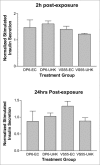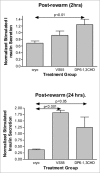Review of vitreous islet cryopreservation: Some practical issues and their resolution
- PMID: 20046679
- PMCID: PMC2781096
- DOI: 10.4161/org.5.3.9812
Review of vitreous islet cryopreservation: Some practical issues and their resolution
Abstract
Transplantation of pancreatic islets for the treatment of diabetes mellitus is widely anticipated to eventually provide a cure once a means for preventing rejection is found without reliance upon global immunosuppression. Long-term storage of islets is crucial for the organization of transplantation, islet banking, tissue matching, organ sharing, immuno-manipulation and multiple donor transplantation. Existing methods of cryopreservation involving freezing are known to be suboptimal providing only about 50% survival. The development of techniques for ice-free cryopreservation of mammalian tissues using both natural and synthetic ice blocking molecules, and the process of vitrification (formation of a glass as opposed to crystalline ice) has been a focus of research during recent years. These approaches have established in other tissues that vitrification can markedly improve survival by circumventing ice-induced injury. Here we review some of the underlying issues that impact the vitrification approach to islet cryopreservation and describe some initial studies to apply these new technologies to the long-term storage of pancreatic islets. These studies were designed to optimize both the pre-vitrification hypothermic exposure conditions using newly developed media and to compare new techniques for ice-free cryopreservation with conventional freezing protocols. Some practical constraints and feasible resolutions are discussed. Eventually the optimized techniques will be applied to clinical allografts and xenografts or genetically-modified islets designed to overcome immune responses in the diabetic host.
Keywords: cryoprotectants; islet banking; islet cryopreservation; islet vitrification; pancreatic islets; rat islets; vitrification.
Figures





Similar articles
-
Pancreatic islet cryopreservation by vitrification achieves high viability, function, recovery and clinical scalability for transplantation.Nat Med. 2022 Apr;28(4):798-808. doi: 10.1038/s41591-022-01718-1. Epub 2022 Mar 14. Nat Med. 2022. PMID: 35288694 Free PMC article.
-
Cryopreservation: Vitrification and Controlled Rate Cooling.Methods Mol Biol. 2017;1590:41-77. doi: 10.1007/978-1-4939-6921-0_5. Methods Mol Biol. 2017. PMID: 28353262 Review.
-
Fabrication of functional rat pseudo-islets after cryopreservation of pancreatic islets or dispersed islet cells.J Tissue Eng Regen Med. 2021 Jul;15(7):686-696. doi: 10.1002/term.3219. Epub 2021 May 22. J Tissue Eng Regen Med. 2021. PMID: 33999537
-
Nylon Mesh Device for Vitrification of Large Quantities of Rat Pancreatic Islets.Biopreserv Biobank. 2017 Oct;15(5):457-462. doi: 10.1089/bio.2017.0044. Epub 2017 Sep 5. Biopreserv Biobank. 2017. PMID: 28872901
-
Cryopreservation by vitrification: a promising approach for transplant organ banking.Curr Opin Organ Transplant. 2018 Jun;23(3):353-360. doi: 10.1097/MOT.0000000000000534. Curr Opin Organ Transplant. 2018. PMID: 29702495 Review.
Cited by
-
Diffusion Limited Cryopreservation of Tissue with Radiofrequency Heated Metal Forms.Adv Healthc Mater. 2020 Oct;9(19):e2000796. doi: 10.1002/adhm.202000796. Epub 2020 Sep 2. Adv Healthc Mater. 2020. PMID: 32875732 Free PMC article.
-
Pancreatic islet cryopreservation by vitrification achieves high viability, function, recovery and clinical scalability for transplantation.Nat Med. 2022 Apr;28(4):798-808. doi: 10.1038/s41591-022-01718-1. Epub 2022 Mar 14. Nat Med. 2022. PMID: 35288694 Free PMC article.
-
Cryoprotectant Toxicity: Facts, Issues, and Questions.Rejuvenation Res. 2015 Oct;18(5):422-36. doi: 10.1089/rej.2014.1656. Epub 2015 Sep 22. Rejuvenation Res. 2015. PMID: 25826677 Free PMC article. Review.
-
Systematic review of islet cryopreservation.Islets. 2018 Jan 2;10(1):40-49. doi: 10.1080/19382014.2017.1405202. Epub 2018 Jan 9. Islets. 2018. PMID: 29315020 Free PMC article.
-
Scaling Effects on the Residual Thermomechanical Stress During Ice-Free Cooling to Storage Temperature.J Appl Mech. 2020 Oct 1;87(10):101003. doi: 10.1115/1.4047420. Epub 2020 Jul 8. J Appl Mech. 2020. PMID: 34168384 Free PMC article.
References
-
- Centers for Disease Control and Prevention, author. National diabetes fact sheet: general information and national estimates on diabetes in the United States, 2007. Atlanta GA US: Department of Health and Human Services, Centers for Disease Control and Prevention; 2008.
-
- American Diabetes Association, author. Economic costs of Diabetes in the US in 2007. Diabetes Care. 2008;31:596–615. - PubMed
-
- Bonner-Weir S, Weir GC. New sources of pancreatic beta-cells. Nat Biotechnol. 2005;23:857–861. - PubMed
-
- Inada A, Bonner-Weir S, Toschi E. How can we get more beta cells? Curr Diab Rep. 2006;6:96–101. - PubMed
-
- Biancone L, Ricordi C. Pancreatic islet transplantation: an update. Cell Transplant. 2002;11:309–311. - PubMed
LinkOut - more resources
Full Text Sources
Other Literature Sources
